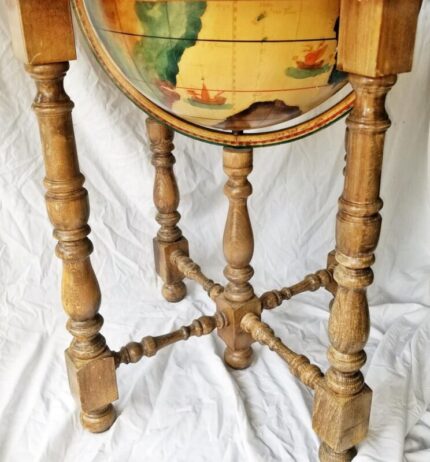The base of this table is a design by Ole Wanscher for the Danish manufacturer PJ Møbler. It was made during the 1960s. It is made of high-quality dark mahogany with an interesting grain. The tabletop is decorated with hand-painted, artistic paintings all around, consistent with the idea of modernist design. The painting is a delicate decoration, the center of the table top is filled with rich mahogany grain. The slender legs are a darker shade of brown than the top.
Ole Wanscher was born in 1903 in Copenhagen. He was a Danish architect and designer and a key player in the Mid-Century Danish Modernist movement. In the post-war era, the simple and refined aesthetics he achieved by reinventing the classic forms helped define Scandinavian design, and many of his works became the staple of Scandinavian homes. Wanscher studied at the Royal Danish Academy of Fine Arts under the famous architect-designer Kaare Klint. Upon graduation, Wanscher worked with Klint from 1924 to 1927, and upon his death he was appointed to Klint’s professorship at the academy – a position he held until his retirement in 1973. Like Klint, Wanscher disagreed with the modernist approach, rejecting the past entirely, and preferred to explore a classic but minimal aesthetic based on a careful study of the human body. Wanscher was also heavily influenced by Greek, Chinese, and Egyptian designs – which he encountered on many journeys – as well as movements such as the Viennese Art Nouveau, Biedermeier, and Shaker.
Poul Jeppeesens Møbelfabrik is a Danish furniture manufacturer, whose projects combine traditional craftsmanship with modern design. Pure, simple aesthetics characterized by a thoughtful form, exceptional comfort and attention to detail is the company’s business card. PJ Møbelfabrik worked with many well-known designers. Ole Wanscher, Grete Jalk, Hans Olsen and Morten Gøttler are just some of them.
This table has been partially restored keeping it’s natural patina. This is a piece of furniture finished according to the rules of the Upcycled Vintage course. Its form is original and dates from the 20th century, but the final finish has been changed by artistic invention or composition of parts from different original object. All treatment are performed by traditional methods, are consistent with the aesthetic of the age from which the furniture comes from and support the Zero Waste idea.
The table is in very good vintage condition. It has minor traces of age.
I have official proof of authenticity such as vintage catalogs,
designer records,
or other literature sources and take full responsibility for any authenticity issues arising
from
misattribution











































Reviews
There are no reviews yet.